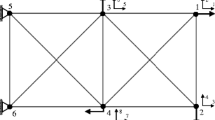Abstract
The finite element discretization of the Signorini Problem leads to a large scale constrained minimization problem. To improve the convergence rate of the projection method preconditioning must be developed. To be effective, the relative condition number of the system matrix with respect to the preconditioning matrix has to be small and the applications of the preconditioner as well as the projection onto the set of feasible elements have to be fast computable. In this paper, we show how to construct and analyze such preconditioners on the basis of domain decomposition techniques. The numerical results obtained for the Signorini problem as well as for contact problems in plane elasticity confirm the theoretical analysis quite well.
Similar content being viewed by others
References
Benassi, M., White, R. E.: Parallel numerical solution of variational inequalities. SIAM J. Numer. Anal.31, 813–830 (1994).
Braess, D., Hackbusch, W.: A new convergence proof for the multigrid method including the V-cycle. SIAM J. Numer. Anal.20, 967–975 (1983).
Bramble, J. H., Pasciak, J. E.: A preconditioning technique for indefinite systems resulting from mixed approximations of elliptic problems. Math. Comput.50, 1–17 (1988).
Bramble, J. H., Pasciak, J. E., Xu. J.: Parallel multilevel preconditioners. Math. Comput.55, 1–22 (1990).
Brezzi, F., Hager, W. W., Raviart, P. A.: Error estimates for the finite element solution of variational inequalities. Numer. Math.28, 431–443 (1977).
Cheng, H.: Iterative solution of elliptic finite element problems on partially refined meshes and the effect of using inexact solvers. PhD thesis, New York University, Courant Institute of Mathematical Sciences, New York, 1993.
Fichera, G.: Boundary value problems of elasticity with unilateral constraints. In: Handbuch der Physik — Encyclopedia of Physics, volume VI a/2 Festkörpermechanik II. Berlin, Heidelberg, New York: Springer 1972.
Glowinski, R., Lions, J.-L., Trémolières, R.: Numerical analysis of variational inequalities. Amsterdam - New York - Oxford. North-Holland, 1981.
Großmann, C., Roos, H. G.: Numerik partieller Differentialgleichunger. Stuttgart: Teubner, 1994.
Gwinner, J.: Finite-element convergence for contact problems in plane linear elastostatics. Math.50, 11–25 (1992).
Haase, G.: Hierarchial extension operators plus smoothing in domain decomposition preconditioners. Appl. Numer. Math.23, 327–346 (1997).
Haase, G., Langer, U.: The non-overlapping domain decomposition multiplicative Schwarz method. Int. J. Comp. Math.44, 223–242 (1992).
Haase, G., Langer, U., Meyer, A.: The approximate Dirichlet domain decomposition method. Part I: An algebraic approach. Part II: Applications to 2nd-order elliptic boundary value problems. Computing47, 137–151, 153–167 (1991).
Haase, G., Langer, U., Meyer, A., Nepomnyaschikh, S.V.: Hierarchial extension operators and local multigrid methods in domain decomposition preconditioners. East-West J. Numer. Math.2, 173–193 (1994).
Hackbusch, W., Mittelmann, H.: On multi-grid methods for variational inequalities. Numer. Math.42, 65–76 (1983).
Han, H.: A direct boundary element method for Signorini problems. Math. Comp.55, 115–128 (1990).
Haslinger, J., Hlaváček, I., Nečas, U.: Numerical methods for unilateral problems in solid mechanics. In: Handbook of numerical analysis, volume 2. Amsterdam: North-Holland, 1996.
Hoffmann, K.-H., Zou, J.: Parallel algorithms of Schwarz variant for variational inequalities. Numer. Funct. Anal. Optim.13, 449–462 (1992).
Hoppe, R. H. W.: Multigrid algorithms for variational inequalities. SIAM J. Numer. Anal.24, 1046–1065 (1987).
Hoppe, R. H. W., Kornhuber, R.: Adaptive multilevel methods for obstacle problems. SIAM. J. Numer. Anal.31, 301–323 (1994).
Jung, M., Langer, U., Meyer, A., Queck, W., Schneider, M.: Multigrid preconditioners and their applications. In: Third multigrid seminar, Biesenthal 1988 (Telschow, G., ed.), p. 11–52. Berlin: Karl-Weierstrass-Institut, 1989.
Kikuchi, N., Oden, J. T.: Contact problems in elasticity: a study of variational inequalities and finite element methods. Philadelphia: SIAM 1988.
Kinderlehrer, D., Stampacchia, G.: An introduction to variational inequalities and their applications. New York: Academic Press 1980.
Lions, P.: On the Schwarz alternating method I. In: Glowinski, R., Golub, G. H., Meurant, G. A., Péiaux, J. (eds.) First International Symposium on Domain Decomposition Methods for Partial Differential Equations, pp. 1–42. SIAM, 1988.
Mandel, J.: A multilevel iterative method for symmetric, positive definite linear complementarity problems. Appl. Math. Optim11, 77–95 (1984).
Nepomnyaschikh, S. V.: Optimal multilevel extension operators. Preprint SPC 95_3, Technische Unviersität Chemnitz-Zwickau, Fakultät für Mathemaik, 1995.
Schmitz, H., Schneider, G., Wendland, W.: Boundary element methods for problems involving unilateral boundary conditions. In: Wriggers, P., Wagner, W., eds. Nonlinear computational mechanics-state of the art, pp. 212–225. Berlin Heidelberg New York, Tokyo: Springer 1991.
Signorini, A.: Sopra alcune questioni di elastostatics. Atti Soc. Ial. Progr. Sci., 1933.
Smith, B. F., Widlund, O.B.: A domain decomposition algorithm using a hierarchical basis. SIAM J. Sci. Stat. Comput.11, 1212–1220 (1990).
Spann, W.: On the boundary element method for the Signorini problem of the Laplacian. Numer. Math.65, 337–356 (1993).
Tao, L., Liem, C.-B., Shih, T.-M.: Parallel algorithms for variational inequalities based on domain decomposition. Syst. Sci. Math. Sci.4, 341–348 (1991).
Tong, C. H., Chan, T. F., Kuo, C. C. J.: A domain decomposition preconditioner based on a change to a multilevel nodal basis. SIAM J. Sci. Stat. Comp.12, 1486–1495 (1991).
Verfürth, R.: A review of a posteriori error estimation and adaptive mesh-refinement techniques. New York: Wiley-Teubner, 1996.
Yserentant, H.: On the multi-level splitting of finite element spaces. Numer. Math.49, 379–412 (1986).
Author information
Authors and Affiliations
Additional information
This research has been supported by the Austrian Science Foundation — ‘Fonds zur Förderung der wissenschaftlichen Forschung (FWF)’ — under project grant P10643-TEC.
Rights and permissions
About this article
Cite this article
Schöberl, J. Solving the signorini problem on the basis of domain decomposition techniques. Computing 60, 323–344 (1998). https://doi.org/10.1007/BF02684379
Received:
Revised:
Issue Date:
DOI: https://doi.org/10.1007/BF02684379




